Tokyo and the Half-baked Theory of Design Zeigeist as Entrenched Japanese Worldview
Tokyo, with its neon skyscraping billboards and cacophony of huge video advertisements and pre-recorded voices competing with loud disparate music and shopkeepers hailing potential passersby with megaphones, is the set of Blade Runner, but with manicured eyebrows, coiffed hair, Muji-like clothes from Uniqlo and United Arrows (and maybe even journal standard. Comme des Garçons rags age rapidly on the shelves so they go out the store and straight into the bargain bin that is Ragtag. Restir's curation probably only works for the Harajuku crowd.) and a bad case of ani-mania.
Tokyo is about Apple outselling Microsoft in a Pecha Kutcha Nights climate.
Tokyo is made for that particular generation of consumers in whose zeitgeist swirl the words "cult", "curated", "edited", "uber", "luxe", "global", "awareness", "design", "interpretative", "emerging", "relevant" and "interventive"; who regularly haunt typophile forums; who dress their kids in rags from Hakka; and, for those with new-agey hangovers, who measure everything by its "carbon footprint", print brochures not on any old recycled paper but FSC-certified paper using soya ink, and eschew Body Shop for Pangea Organics.
In Tokyo, a general goods store isn't just a Mustafa. Tokyu Hands, for instance, and Ginza Hands in particular, is stocked with stuff that people who previously read Wallpaper* and who now flip Monocle and Superfuture would rave about. Like the entire Holga range; like Yoshida's Porter bags and other luggage whose websites are Flash-run as a matter-of-course (Samsonite, even Philippe Starck for Samsonite? So 1990s.); like METAPHYS products.
Ito-ya, the stationery place, is more than Rhoda and Moleskine notebooks (which, hello, can be bought from mere convenience stores) and Freitag bags (very 2005/2006, now sold in street stalls).
hhstyle.com stocks the *yawn* usual cult furniture designs by Eames, Panton, Gehry et al (Gyre Omotesando uses them as public seating, courtesy of their MoMA Design Store tenant). Plus minus zero, sold in normal design stores everywhere, pushes more recent 2007 stuff by Fukasawa.
And because big high street brands and Bubble economy construction are so 1980s, "luxury brands" clothe themselves with street cred - the works of artisan developers (architects are very last century, ok): Chanel on Ginza wears Peter Morino, Prada in Aoyoma wears Jacques Herzog and Pierre de Meuron, Mikimoto Ginza 2 - Toyo Ito, etc. Asahi's Super Dry Hall got saddled with Philippe Starck, Tokyo being famously where has-been Western celebs come to wring out some money from their historical celebrity as celebrated by Lost In Translation (Brad Pitt-o and Cameron Diaz for Softbank...etc. Just have a look at Japan Ads.). The locals lovingly call Starck's work "the golden turd". Well, if your sewers looked like this, you'd think Starck vulgar too.
"Gourmet", another watchword of the zeitgeist, has its own fetishistic brand names, like Dean & Deluca where 12 different types of salt can be sampled. And what is gourmet food without the accompanying gourmet kitchen appliances beyond the country-bumpkin Kitchenaid and Cuisinart. Leaving nothing to chance, a gourmet fruit shop, Sun Fruits, sells gourmet fruits, like 12 very red strawberries with very good skin - Tochiotome or Hinoshizuku varieties - for 100,000 yen.
Not to be left out of this post-postmodern post-poststructuralist world, every season, chocolatiers and patissiers catwalk their couture, play-acting haute fashion houses. Pierre Hermé with cakes in precious timepiece glass showcases, Le Chocolate de H which packs little chocolate truffles like Tiffany rings, Sadaharu Aoki which...well, just listen to the hordes of Japanese ladies cooing "Oiiishiii!" at the pink tower of macaroons and slivers of matcha cake, Jean Paul Hevin etc.
Perhaps as a pre-emptive strike against any pricks of conscience apropos this conspicuous consumption, it is also consumption itself that is being marketed and sold. Marketing being never about communicating mere facts but about selling values, a lifestyle, Tokyo Midtown plays up its design-conscious image with quiet bamboo spaces, pitchblack interiors at Restir, food-as-museum-exhibits at Toraya, an enormous red cloth-hanging at Belberry, the Suntory Museum of Art and a contemporary art gallery, 21_21 design sight.
Gyre devotes shop space to an exhibition of MVRDV's other projects, complete with laptops and styrafoam models. (Check out Pig City. Book Mountain must be a sight to behold at night from beyond the glass walls.)
This meta-marketing, this marketing of consumption, is naturally rather vague. A general direction of beauty and design. A dab of the artisanal and handmade over the mass-produced. A smear of curation and editing, that historical preserve of art galleries and museum collections. And of course, a vast background watercolour wash about the environment. Take for example Gyre's (ahem) curated consumption concept, "shop and think":
But perhaps the pre-empted pricks of conscience are but foreign imports available to the very few; the very few, if one goes with the Sapir–Whorf hypothesis, who have actually mastered a Western tongue.
Perhaps Roland Barthes, opining in Empire of Signs on a Japan he was too lazy to either recreate as complete fiction or understand as fact (since, in any case, it was not in his interest to distinguish between fiction and fact), had, nonetheless, a point. Perhaps zen-soaked mindset of the Japanese has created a culture empty of internal substance; a culture in which the gift is not within the wrapping but in the elaborately-wrapped package itself; a culture steeped in a worldview where empty signs, like haiku poems, are not expected to lead to final signifieds. Perhaps postmodernism, poststructuralism, deconstructionism are concepts that are meaningless in Japan where there was never any modernism or structuralism or construct. Derrida heaven (beautifully packaged, of course).
Staying in Akasuka during the Battledore Festival was like walking out into an Edo-style Disneyland every morning, with its little shops selling kibbi-balls and warm sake, ningyoyaki just off the press and hot manju. And the locals dig this simulacra. One evening, I stopped to take a picture of 2 geishas disappearing into a restaurant and a Buddhist nun waddled up to me excitedly. "Oooowaaaaaa!" she gushed and in 3 seconds, a small crowd of handphone camera-wielding locals had formed behind me.
Entering the Imperial Palace on one of the only two days commoners are allowed into its hallowed grounds, the Emperor's birthday, was like a gander in a different part of Disneyland. The main attraction was the sight of the imperial family behind a bulletproof screen. When they appeared, the crowd yelled "banzai!" and waved their flags for a minute while like the mechanical dolls, the royals turned and waved in perfect synchronisation. Then the Emperor gave a short speech (an American in the crowd paraphrased it as "Hey everyone, thanks for coming. I really appreciate it. Yeah, I really do. So thanks, y'all." But he's American and therefore, not to be trusted. ;-)).
Thereafter, a minute of banzai-yelling, flag-waving and royal-clockwork-movement before the royals turned away and disappeared behind a screen, and the crowd stowed away their cameras, rolled up their flags and filed out of the square, making way for the next batch of tourists.
It is for this reason that Japan intrigues me. (The fascination with the Other?) How much satisfaction does this Other gain from an existence based on production and consumption like some late-stage capitalist nightmare (or is this a nightmare only to the Western mindset)? How accurate Jean-François Lyotard's theories about Shinto-ism as postmodern erasure of historicity? And how has this led to the Japanese view of their role in World War II (itself arguably a Western concept)? What of the animation of Hayao Miyazaki? What of the alienation and loneliness in the works of Haruki Murakami - are these felt by a majority of the Japanese population or merely a result of his being heavily influenced by Western culture? How are the successful advertising campaigns by Western celebrities explained in a culture without ultimate signifieds?
What methodologies can be used to speak the truth to a culture in which truth is, allegedly, marginal?
How many of the ideas in this post are based on Western myths of inscrutable occidentalism?
_____________________________________________________________________
A quick jot-down of information that was useful to me:
Accommodation
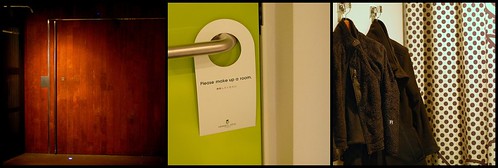
Claska (if you can make it before it shuts for renovations) or Granbell Hotel for design-phreaks.
Transportation from Narita Airport
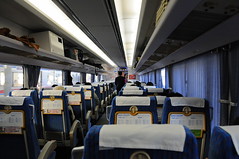
The Keisei Skyliner features baggage racks and comfy seating with vending machines and toilets in the middle carriages. It costs ¥1920 from Narita Airport Terminal 2 to Ueno and requires reservations. Time to Ueno is about 51 minutes.
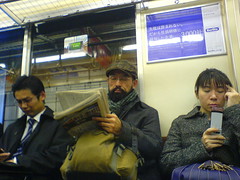
The Keisei Railways Limited Express is a regular train with free seating and an opportunity for your luggage to bruise the knees of strangers. No vending machines or toilets in the train. But, hey, it costs ¥1000 from Narita Airport Terminal 2 to Ueno. Time to Ueno is about 71 minutes.
Getting Around
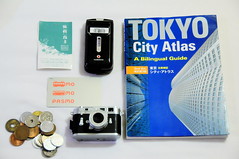
If you intend to find a specific place that isn't on a conventional tourist map, must haves are: (1) the Tokyo City Atlas (Bilingual); (2) a Tokyo Subway Map; (3) a pen, spare paper and a ready smile.
The Tokyo City Atlas is useful because unlike the locate-by-street convention of many other places, Central Tokyo addresses are read like so: there is the name of the ward (ku). There are smaller named districts within the ward (cho). And then come the numbers: the first number is the main area (chome), the second number is the block, and the third is the specific building. None of this makes sense unless you have an atlas.
There are a number of combinations of frequent travel tickets available. They don't save that much and are quite restrictive if you're not quite sure what you'll be doing on any given day, so I went with a Pasmo card (interchangeable with the Suica) which is a contactless smart card much like the Translink card for the Singapore MRT-bus system. Saved a lot of time by cutting out all that fumbling for change.
Even Tokyoites need directions to find their way around Tokyo. Numerous maps of the environs at subway stations. And when those didn't help, everyone I approached was really friendly and willing to help even if he/she didn't speak English.
If you're staying in a ryokan or some other place with a curfew, bring along the password and keys to get back into your accommodation at night.
Food
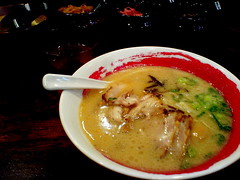 versus
versus 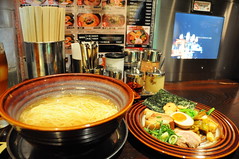
Ramen: preferred Ippudo (一風堂) to Kohmen (光麺), Hakata-style tonkotsu ramen in pork bone soup to shoyu broth. Branches everywhere.
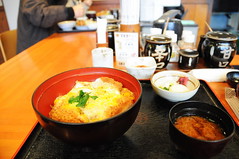
Tonkatsu: the tenderness of Maisen's pork cutlet, a dish introduced during the Meiji period when meat-eating began to catch on in the vegetarian country, is apparently due to the fact that their pigs come from Okita Farm on Kyushu, southern Japan, where they roam about freely and munch on sweet potatoes and wheat.
Maisen
4-8-5 Jingumae, Shibuya-ku
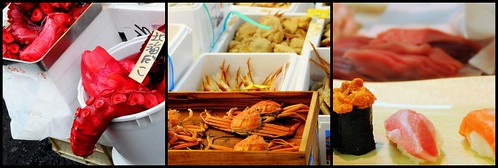
Sushi/sashimi: Sushizenmai. Good for a morning snack after a walk around the Tsukiji Fish Market (4-10-2 Tsukiji). While you're around Tsukiji, get some grilled scallops too.
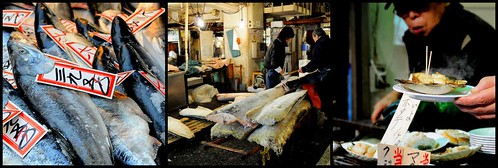
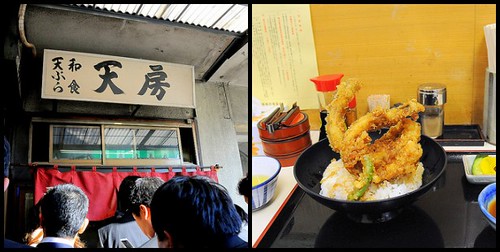
Tempura: Tenfusa (5-2-1 Tsukiji). The eel tempura was excellent. Eel was fresh and no oily heaviness in the tempura.

Okonomiyaki: Asakusa Sometaro. A traditional okonomiyaki place where shoe-removal was a necessary prelude to sitting around a hotplate on tatami mats and attempting not to burn the okonomiyaki. Apparently the best okonomiyaki in Tokyo.
Asakusa Sometaro
2-2-2 Nishi-Asakusa
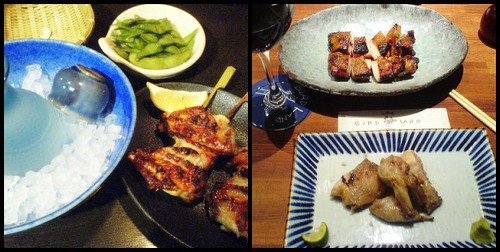
An izakaya is where, sometimes, yakitori and beer/wine/sake meet for a good time. Birdland did excellent free-range chicken yakitori and Negiya Heikichi boasted leek as its speciality: roasted on the outside, creamy on the inside.
Birdland
4-2-15 Ginza
Negiya Heikichi
36-18 Udagawa, Shibuya-ku
The food halls (called "depachika" - "depa" = "department store" and "chicka" = "basement") in the basement of shopping malls are massive affairs. Good for cheap takeaways. Better than instant noodles from a convenience store. Check out Isetan Shinjuku and Tokyu Foodshow at Shibuya.
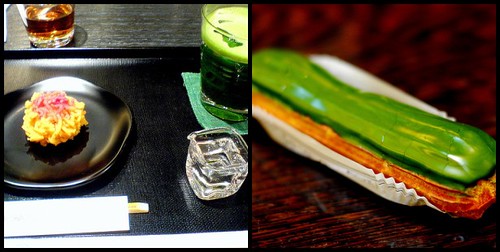
Pretty pastries: patissiers are artists in bakers' clothing in Tokyo. See, for example, Sadaharu Aoki, Hidemi Sugino, Pierre Hermé. Toraya for Japanese confections. For chocolate, see Jean-Paul Hévin and Le Chocolat de H.
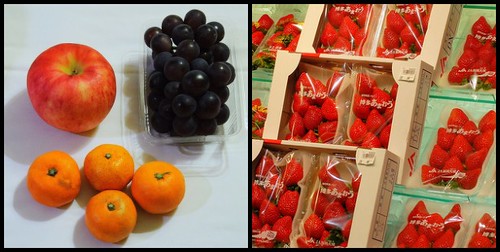
Fresh fruits: everywhere. And, like Legolas, suspiciously flawless.
Shopping
Bespoke clothes and luggage and leather shoes: Aoyama, Ginza, Roppongi, upper Meiji-dori.
Street fashion: Shibuya 109, small streets off Aoyama, Harajuku, Cat Street, Meiji-dori, Laforet.

Electronics: Bic Camera, Yodobashi and Sakuraya (look for their mascot - a plump lass with pink bunny ears acting cute) are the big electronics stores around Shinjuku where you can play around with the display sets and for cameras, the various combinations of lenses. There's also Map Camera round the corner and small stores selling secondhand cameras in the area. Check prices on Clubsnap (for Singapore) and Kakaku (for Japan) beforehand. Akihabara ("Akiba") is otaku paradise with anime and maid cafes thrown in. Naturally, the real otaku have moved elsewhere. The Yodobashi in Akiba is massive-r. Remember that most electrical stuff come only with domestic warranty. If you want a tax refund on your purchases, bring along your passport. Some stores only do tax refunds on the date of purchase. (In the larger stores, playing around with the inhouse points system may get you a cheaper price than getting a tax refund.)
Japanese souvenirs: Oriental Bazaar on Omotesando.
Japanese Snacks: Ueno. Also one of the few places you can get your pocket picked in Tokyo.

Hot Japanese Snacks: mosey up the lanes leading to Sensoji in the morning.
Happenings and Events: Refer to Metropolis. Music-wise, jazz is bigger in Tokyo than it is in its hometown.
No 3G phone? Rent one at Narita Airport from Softbank.
Internet is ubiquitous but internet cafes are not.
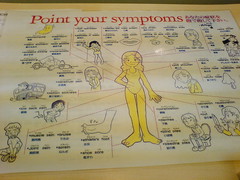
Not feeling too well and don't speak Japanese? Easy-peasy. "Point Your Symptoms."
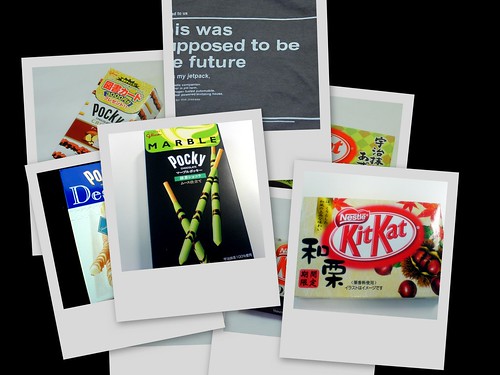
This is supposed to be the future. Where is my jet-pack? No jet-pack? Oh, ok. Matcha and chestnut-flavoured Pocky and Kitkat's fine too.
Tokyo is about Apple outselling Microsoft in a Pecha Kutcha Nights climate.
Tokyo is made for that particular generation of consumers in whose zeitgeist swirl the words "cult", "curated", "edited", "uber", "luxe", "global", "awareness", "design", "interpretative", "emerging", "relevant" and "interventive"; who regularly haunt typophile forums; who dress their kids in rags from Hakka; and, for those with new-agey hangovers, who measure everything by its "carbon footprint", print brochures not on any old recycled paper but FSC-certified paper using soya ink, and eschew Body Shop for Pangea Organics.
In Tokyo, a general goods store isn't just a Mustafa. Tokyu Hands, for instance, and Ginza Hands in particular, is stocked with stuff that people who previously read Wallpaper* and who now flip Monocle and Superfuture would rave about. Like the entire Holga range; like Yoshida's Porter bags and other luggage whose websites are Flash-run as a matter-of-course (Samsonite, even Philippe Starck for Samsonite? So 1990s.); like METAPHYS products.
Ito-ya, the stationery place, is more than Rhoda and Moleskine notebooks (which, hello, can be bought from mere convenience stores) and Freitag bags (very 2005/2006, now sold in street stalls).
hhstyle.com stocks the *yawn* usual cult furniture designs by Eames, Panton, Gehry et al (Gyre Omotesando uses them as public seating, courtesy of their MoMA Design Store tenant). Plus minus zero, sold in normal design stores everywhere, pushes more recent 2007 stuff by Fukasawa.
And because big high street brands and Bubble economy construction are so 1980s, "luxury brands" clothe themselves with street cred - the works of artisan developers (architects are very last century, ok): Chanel on Ginza wears Peter Morino, Prada in Aoyoma wears Jacques Herzog and Pierre de Meuron, Mikimoto Ginza 2 - Toyo Ito, etc. Asahi's Super Dry Hall got saddled with Philippe Starck, Tokyo being famously where has-been Western celebs come to wring out some money from their historical celebrity as celebrated by Lost In Translation (Brad Pitt-o and Cameron Diaz for Softbank...etc. Just have a look at Japan Ads.). The locals lovingly call Starck's work "the golden turd". Well, if your sewers looked like this, you'd think Starck vulgar too.
"Gourmet", another watchword of the zeitgeist, has its own fetishistic brand names, like Dean & Deluca where 12 different types of salt can be sampled. And what is gourmet food without the accompanying gourmet kitchen appliances beyond the country-bumpkin Kitchenaid and Cuisinart. Leaving nothing to chance, a gourmet fruit shop, Sun Fruits, sells gourmet fruits, like 12 very red strawberries with very good skin - Tochiotome or Hinoshizuku varieties - for 100,000 yen.
Not to be left out of this post-postmodern post-poststructuralist world, every season, chocolatiers and patissiers catwalk their couture, play-acting haute fashion houses. Pierre Hermé with cakes in precious timepiece glass showcases, Le Chocolate de H which packs little chocolate truffles like Tiffany rings, Sadaharu Aoki which...well, just listen to the hordes of Japanese ladies cooing "Oiiishiii!" at the pink tower of macaroons and slivers of matcha cake, Jean Paul Hevin etc.
Perhaps as a pre-emptive strike against any pricks of conscience apropos this conspicuous consumption, it is also consumption itself that is being marketed and sold. Marketing being never about communicating mere facts but about selling values, a lifestyle, Tokyo Midtown plays up its design-conscious image with quiet bamboo spaces, pitchblack interiors at Restir, food-as-museum-exhibits at Toraya, an enormous red cloth-hanging at Belberry, the Suntory Museum of Art and a contemporary art gallery, 21_21 design sight.
Gyre devotes shop space to an exhibition of MVRDV's other projects, complete with laptops and styrafoam models. (Check out Pig City. Book Mountain must be a sight to behold at night from beyond the glass walls.)
This meta-marketing, this marketing of consumption, is naturally rather vague. A general direction of beauty and design. A dab of the artisanal and handmade over the mass-produced. A smear of curation and editing, that historical preserve of art galleries and museum collections. And of course, a vast background watercolour wash about the environment. Take for example Gyre's (ahem) curated consumption concept, "shop and think":
The things you buy connect you to the whole world.Right.
In this world there are many beautiful things. There are also many difficult problems.
Please be conscious of these facts behind your GYRE experience.
How do the things you buy connect you to the world?
They stimulate your imagining, polishing the way you shop.
You may choose, for example, garments you will wear for a long time, their materials brought to life by a craftsman's special skill.
You encounter designs that bring inspiration to everyday life.
You enjoy safe, delicious food from producers who care deeply about the environment.
You are moved by the richness and beauty of the seasons.
By raising your consciousness,
your shopping can have a positive impact on the world as well as yourself.
But perhaps the pre-empted pricks of conscience are but foreign imports available to the very few; the very few, if one goes with the Sapir–Whorf hypothesis, who have actually mastered a Western tongue.
Perhaps Roland Barthes, opining in Empire of Signs on a Japan he was too lazy to either recreate as complete fiction or understand as fact (since, in any case, it was not in his interest to distinguish between fiction and fact), had, nonetheless, a point. Perhaps zen-soaked mindset of the Japanese has created a culture empty of internal substance; a culture in which the gift is not within the wrapping but in the elaborately-wrapped package itself; a culture steeped in a worldview where empty signs, like haiku poems, are not expected to lead to final signifieds. Perhaps postmodernism, poststructuralism, deconstructionism are concepts that are meaningless in Japan where there was never any modernism or structuralism or construct. Derrida heaven (beautifully packaged, of course).
Staying in Akasuka during the Battledore Festival was like walking out into an Edo-style Disneyland every morning, with its little shops selling kibbi-balls and warm sake, ningyoyaki just off the press and hot manju. And the locals dig this simulacra. One evening, I stopped to take a picture of 2 geishas disappearing into a restaurant and a Buddhist nun waddled up to me excitedly. "Oooowaaaaaa!" she gushed and in 3 seconds, a small crowd of handphone camera-wielding locals had formed behind me.
Entering the Imperial Palace on one of the only two days commoners are allowed into its hallowed grounds, the Emperor's birthday, was like a gander in a different part of Disneyland. The main attraction was the sight of the imperial family behind a bulletproof screen. When they appeared, the crowd yelled "banzai!" and waved their flags for a minute while like the mechanical dolls, the royals turned and waved in perfect synchronisation. Then the Emperor gave a short speech (an American in the crowd paraphrased it as "Hey everyone, thanks for coming. I really appreciate it. Yeah, I really do. So thanks, y'all." But he's American and therefore, not to be trusted. ;-)).
Thereafter, a minute of banzai-yelling, flag-waving and royal-clockwork-movement before the royals turned away and disappeared behind a screen, and the crowd stowed away their cameras, rolled up their flags and filed out of the square, making way for the next batch of tourists.
It is for this reason that Japan intrigues me. (The fascination with the Other?) How much satisfaction does this Other gain from an existence based on production and consumption like some late-stage capitalist nightmare (or is this a nightmare only to the Western mindset)? How accurate Jean-François Lyotard's theories about Shinto-ism as postmodern erasure of historicity? And how has this led to the Japanese view of their role in World War II (itself arguably a Western concept)? What of the animation of Hayao Miyazaki? What of the alienation and loneliness in the works of Haruki Murakami - are these felt by a majority of the Japanese population or merely a result of his being heavily influenced by Western culture? How are the successful advertising campaigns by Western celebrities explained in a culture without ultimate signifieds?
What methodologies can be used to speak the truth to a culture in which truth is, allegedly, marginal?
How many of the ideas in this post are based on Western myths of inscrutable occidentalism?
_____________________________________________________________________
A quick jot-down of information that was useful to me:
Accommodation

Claska (if you can make it before it shuts for renovations) or Granbell Hotel for design-phreaks.
Transportation from Narita Airport

The Keisei Skyliner features baggage racks and comfy seating with vending machines and toilets in the middle carriages. It costs ¥1920 from Narita Airport Terminal 2 to Ueno and requires reservations. Time to Ueno is about 51 minutes.

The Keisei Railways Limited Express is a regular train with free seating and an opportunity for your luggage to bruise the knees of strangers. No vending machines or toilets in the train. But, hey, it costs ¥1000 from Narita Airport Terminal 2 to Ueno. Time to Ueno is about 71 minutes.
Getting Around

If you intend to find a specific place that isn't on a conventional tourist map, must haves are: (1) the Tokyo City Atlas (Bilingual); (2) a Tokyo Subway Map; (3) a pen, spare paper and a ready smile.
The Tokyo City Atlas is useful because unlike the locate-by-street convention of many other places, Central Tokyo addresses are read like so: there is the name of the ward (ku). There are smaller named districts within the ward (cho). And then come the numbers: the first number is the main area (chome), the second number is the block, and the third is the specific building. None of this makes sense unless you have an atlas.
There are a number of combinations of frequent travel tickets available. They don't save that much and are quite restrictive if you're not quite sure what you'll be doing on any given day, so I went with a Pasmo card (interchangeable with the Suica) which is a contactless smart card much like the Translink card for the Singapore MRT-bus system. Saved a lot of time by cutting out all that fumbling for change.
Even Tokyoites need directions to find their way around Tokyo. Numerous maps of the environs at subway stations. And when those didn't help, everyone I approached was really friendly and willing to help even if he/she didn't speak English.
If you're staying in a ryokan or some other place with a curfew, bring along the password and keys to get back into your accommodation at night.
Food
 versus
versus 
Ramen: preferred Ippudo (一風堂) to Kohmen (光麺), Hakata-style tonkotsu ramen in pork bone soup to shoyu broth. Branches everywhere.

Tonkatsu: the tenderness of Maisen's pork cutlet, a dish introduced during the Meiji period when meat-eating began to catch on in the vegetarian country, is apparently due to the fact that their pigs come from Okita Farm on Kyushu, southern Japan, where they roam about freely and munch on sweet potatoes and wheat.
Maisen
4-8-5 Jingumae, Shibuya-ku

Sushi/sashimi: Sushizenmai. Good for a morning snack after a walk around the Tsukiji Fish Market (4-10-2 Tsukiji). While you're around Tsukiji, get some grilled scallops too.


Tempura: Tenfusa (5-2-1 Tsukiji). The eel tempura was excellent. Eel was fresh and no oily heaviness in the tempura.

Okonomiyaki: Asakusa Sometaro. A traditional okonomiyaki place where shoe-removal was a necessary prelude to sitting around a hotplate on tatami mats and attempting not to burn the okonomiyaki. Apparently the best okonomiyaki in Tokyo.
Asakusa Sometaro
2-2-2 Nishi-Asakusa

An izakaya is where, sometimes, yakitori and beer/wine/sake meet for a good time. Birdland did excellent free-range chicken yakitori and Negiya Heikichi boasted leek as its speciality: roasted on the outside, creamy on the inside.
Birdland
4-2-15 Ginza
Negiya Heikichi
36-18 Udagawa, Shibuya-ku
The food halls (called "depachika" - "depa" = "department store" and "chicka" = "basement") in the basement of shopping malls are massive affairs. Good for cheap takeaways. Better than instant noodles from a convenience store. Check out Isetan Shinjuku and Tokyu Foodshow at Shibuya.

Pretty pastries: patissiers are artists in bakers' clothing in Tokyo. See, for example, Sadaharu Aoki, Hidemi Sugino, Pierre Hermé. Toraya for Japanese confections. For chocolate, see Jean-Paul Hévin and Le Chocolat de H.

Fresh fruits: everywhere. And, like Legolas, suspiciously flawless.
Shopping
Bespoke clothes and luggage and leather shoes: Aoyama, Ginza, Roppongi, upper Meiji-dori.
Street fashion: Shibuya 109, small streets off Aoyama, Harajuku, Cat Street, Meiji-dori, Laforet.

Electronics: Bic Camera, Yodobashi and Sakuraya (look for their mascot - a plump lass with pink bunny ears acting cute) are the big electronics stores around Shinjuku where you can play around with the display sets and for cameras, the various combinations of lenses. There's also Map Camera round the corner and small stores selling secondhand cameras in the area. Check prices on Clubsnap (for Singapore) and Kakaku (for Japan) beforehand. Akihabara ("Akiba") is otaku paradise with anime and maid cafes thrown in. Naturally, the real otaku have moved elsewhere. The Yodobashi in Akiba is massive-r. Remember that most electrical stuff come only with domestic warranty. If you want a tax refund on your purchases, bring along your passport. Some stores only do tax refunds on the date of purchase. (In the larger stores, playing around with the inhouse points system may get you a cheaper price than getting a tax refund.)
Japanese souvenirs: Oriental Bazaar on Omotesando.
Japanese Snacks: Ueno. Also one of the few places you can get your pocket picked in Tokyo.

Hot Japanese Snacks: mosey up the lanes leading to Sensoji in the morning.
Happenings and Events: Refer to Metropolis. Music-wise, jazz is bigger in Tokyo than it is in its hometown.
No 3G phone? Rent one at Narita Airport from Softbank.
Internet is ubiquitous but internet cafes are not.

Not feeling too well and don't speak Japanese? Easy-peasy. "Point Your Symptoms."

This is supposed to be the future. Where is my jet-pack? No jet-pack? Oh, ok. Matcha and chestnut-flavoured Pocky and Kitkat's fine too.
Labels: Art/Architecture/Design, Haruki Murakami, Travels, Travels: Japan
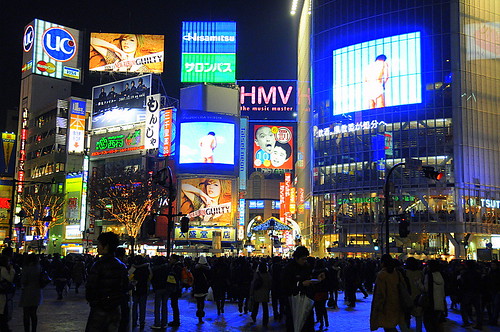
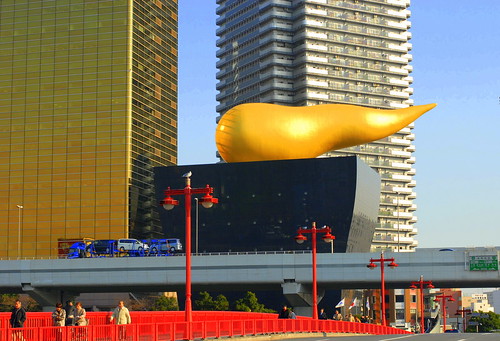
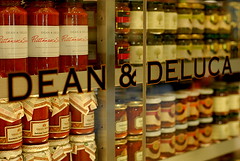
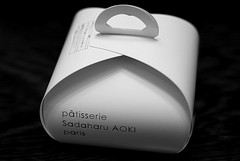
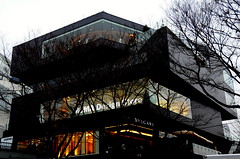

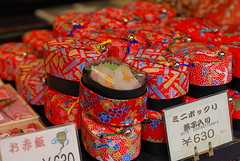
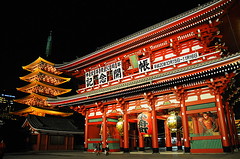
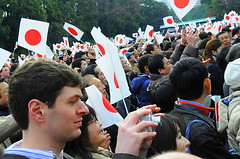










2 Comments:
there is a dean and delucca in tokyo???? ahhhh!!!!!
if u go back can you pick up a chocolate bubka? that is way better than any kind of donut *drool*
hmm is that why the d&d in nyc is in soho?
Yes, will surely hunt down chocolate bubkas for you and your lovely wife (bubkas: in the plural so as to pre-empt any need to sacrificially share one bubka).
Wait. Isn't Japan supposed to be the destination for your honeymoon?
Post a Comment
Subscribe to Post Comments [Atom]
<< Home